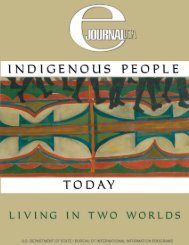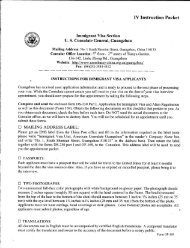s. history us history us history - Embassy of the United States
s. history us history us history - Embassy of the United States
s. history us history us history - Embassy of the United States
- No tags were found...
You also want an ePaper? Increase the reach of your titles
YUMPU automatically turns print PDFs into web optimized ePapers that Google loves.
CHAPTER 1: EARLY AMERICAOUTLINE OF U.S. HISTORYTHE ENDURING MYSTERY OF THE ANASAZITime-worn pueblos and dramatic cliff towns, set amid <strong>the</strong> stark, rugged mesasand canyons <strong>of</strong> Colorado and New Mexico, mark <strong>the</strong> settlements <strong>of</strong> some <strong>of</strong><strong>the</strong> earliest inhabitants <strong>of</strong> North America, <strong>the</strong> Anasazi (a Navajo word meaning“ancient ones”).By 500 A.D. <strong>the</strong> Anasazi had established some <strong>of</strong> <strong>the</strong> first villages in<strong>the</strong> American Southwest, where <strong>the</strong>y hunted and grew crops <strong>of</strong> corn, squash,and beans. The Anasazi flourished over <strong>the</strong> centuries, developing sophisticateddams and irrigation systems; creating a masterful, distinctive pottery tradition;and carving multiroom dwellings into <strong>the</strong> sheer sides <strong>of</strong> cliffs that remainamong <strong>the</strong> most striking archaeological sites in <strong>the</strong> <strong>United</strong> <strong>States</strong> today.Yet by <strong>the</strong> year 1300, <strong>the</strong>y had abandoned <strong>the</strong>ir settlements, leaving <strong>the</strong>irpottery, implements, even clothing — as though <strong>the</strong>y intended to return — andseemingly vanished into <strong>history</strong>. Their homeland remained empty <strong>of</strong> humanbeings for more than a century — until <strong>the</strong> arrival <strong>of</strong> new tribes, such as <strong>the</strong>Navajo and <strong>the</strong> Ute, followed by <strong>the</strong> Spanish and o<strong>the</strong>r European settlers.The story <strong>of</strong> <strong>the</strong> Anasazi is tied inextricably to <strong>the</strong> beautiful but harshenvironment in which <strong>the</strong>y chose to live. Early settlements, consisting <strong>of</strong> simplepitho<strong>us</strong>es scooped out <strong>of</strong> <strong>the</strong> ground, evolved into sunken kivas (undergroundrooms) that served as meeting and religio<strong>us</strong> sites. Later generations developed<strong>the</strong> masonry techniques for building square, stone pueblos. But <strong>the</strong> most dramaticchange in Anasazi living was <strong>the</strong> move to <strong>the</strong> cliff sides below <strong>the</strong> flattoppedmesas, where <strong>the</strong> Anasazi carved <strong>the</strong>ir amazing, multilevel dwellings.The Anasazi lived in a communal society. They traded with o<strong>the</strong>r peoplesin <strong>the</strong> region, but signs <strong>of</strong> warfare are few and isolated. And although <strong>the</strong> Anasazicertainly had religio<strong>us</strong> and o<strong>the</strong>r leaders, as well as skilled artisans, socialor class distinctions were virtually nonexistent.Religio<strong>us</strong> and social motives undoubtedly played a part in <strong>the</strong> building<strong>of</strong> <strong>the</strong> cliff communities and <strong>the</strong>ir final abandonment. But <strong>the</strong> struggle to raisefood in an increasingly difficult environment was probably <strong>the</strong> paramount factor.As populations grew, farmers planted larger areas on <strong>the</strong> mesas, ca<strong>us</strong>ingsome communities to farm marginal lands, while o<strong>the</strong>rs left <strong>the</strong> mesa tops for<strong>the</strong> cliffs. But <strong>the</strong> Anasazi couldn’t halt <strong>the</strong> steady loss <strong>of</strong> <strong>the</strong> land’s fertilityfrom constant <strong>us</strong>e, nor withstand <strong>the</strong> region’s cyclical droughts. Analysis <strong>of</strong> treerings, for example, shows that a drought lasting 23 years, from 1276 to 1299,finally forced <strong>the</strong> last groups <strong>of</strong> Anasazi to leave permanently.Although <strong>the</strong> Anasazi dispersed from <strong>the</strong>ir ancestral homeland, <strong>the</strong>irlegacy remains in <strong>the</strong> remarkable archaeological record that <strong>the</strong>y left behind,and in <strong>the</strong> Hopi, Zuni, and o<strong>the</strong>r Pueblo peoples who are <strong>the</strong>ir descendants. Major Native American cultural groupings, A.D. 500-1300.2021












